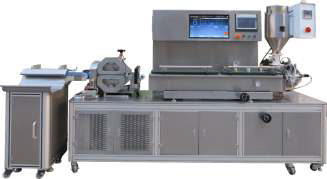|
Micro Extrusion Contribute To
Improvements In Medical Device Production, Patient
Satisfaction
(Abstracted from an article
by Bob Donohue, Navtar, a Tekni-Plex Company as
published in published in medicalplasticsnews.com )
• Because of new technological developments, the
definition of what constitutes microextrusion medical
tubing has shifted.
• What was once called a microextrusion—typically a
.015 inner diameter (ID) x .055 outer diameter (OD)—is
now considered a standard extrusion. What used to be
outlier dimensions are now considered common. In the
past, these micro tubes were produced out of glass or,
in the case of fluoropolymers, involved a secondary
stretching operation to achieve the desired ID and OD.

• However, advances in plastic extrusion technology
have changed the game. With minimally-invasive surgery
becoming the wave of the future, microextrusion is
allowing device manufacturers to provide products that
otherwise would be difficult to achieve or expensive.
The latest microextrusion tubing can now help OEMs
develop complex devices that can provide therapies and
treatments not previously possible for hard-toaccess
extremities.
• Today’s new microextrusion definition is an ID size
in the 35 microns (or .0014 inch) range, with very
thin walls and extremely tight tolerances to meet the
needs of newer invasive applications.
• Now that extrusion technology (both process and
equipment) has caught up with the needs of the medical
device industry, the latest microextrusion tubing can
now be made in a one-step process from less expensive
materials. The latest die designs, pressure
transducers and high-end, inline, closed-loop
controls, are a few of the many breakthroughs that
have contributed to the development of thermoplastic
microextrusion tubing.
• It is also important to point out that multilayer
microextrusions in catheter applications is another
main driver behind these developments. Being able to
use microextrusion technology in combination with
coextrusion technology adds many new options for OEMs.
This can allow for a highly lubricious inner surface
(for device insertion), along with steerable
characteristics, by modifying the outer shell of the
catheter. This technology allows for the use of radio
opaque indicators to be incorporated into the design
without affecting performance.
Precision provides significant performance, production
impact
The ability to consistently manufacture microextrusion
tubing in tight tolerances impacts both device
production, as well as patient satisfaction.
Catheters, for example, are typically tipformed and
punched. When there are wide tolerance variances, the
consumer experience will not be consistent each time
he or she needs to catheterise themselves. One
catheter tip may be painful upon insertion, while the
next one might not be. Lack of consistency can result
in consumer discomfort and stress in not knowing what
the next usage experience will bring. When
microextrusions are able to hold tight tolerances,
then catheters are consistent and so is the consumer
experience.
There are other applications, such as those where
precise delivery is required, where tight tolerances
also can have a positive impact. A good example to
look at is a tube used for wound therapy. In this
application, medication needs to be precisely
administered to the wound area. Traditionally, liquid
has been pushed through the tube to see how much
volume was coming out. The tube would then be cut to
get to the approximate correct volume. This less-thanprecise
way of delivering medication was the workaround used
to compensate for an ID that was not in tight
tolerance. Conversely, when the tube consistently
delivers tight tolerances through out its production
run, then you are able to eliminate the delivery
guesswork. It also benefits the device manufacturer by
enabling higher throughput.
Potential applications
Potential applications for the latest microextrusion
tubing are extensive and include both implantable
devices and minimallyinvasive procedures.
Possibilities include:
Heart leads. Connecting a pacemaker to the heart
muscles.
Neurological. Treatments for stroke patients where
micro stents need to be inserted into the vascular
system to open capillaries to eliminate blockage.
Vascular. Below the knee procedures such as arterial
drills to assist in blood flow below the knee that has
been compromised by diabetes.
Catheters. Traditionally, heart catheterisation
procedures use the femoral artery in the leg to access
the body. Microextrusions would enable smaller devices
to enter the brachial artery and aid in expanding
smaller vessels that have potential blockage. With the
capability to get into the smaller veins, as well as
the larger ones, more of the heart is accessible.
In vitro fertilization. The new microextrusion
technology can assist with a critical step of the in
vitro fertilization process that enables the nucleus
of the egg to be harvested more precisely.
Infant/paediatric care. The effectiveness of miniature
devices, such as microcatheters that are engineered
for the youngest among us, can also benefit from
microextrusion tubing. Additional opportunities exist
for treatments in the following areas: chemotherapy,
auditory, ophthalmic, wound care, spinal therapies and
others where smaller diameters and tight tolerances
are necessary to achieve product objectives.
(https://www.medicalplasticsnews.com/medical-plasticsindustry-insights/how-microextrusion-medical-tubing-is-leadingto-new-procedur/,
22 AUGUST 2017 ) |
